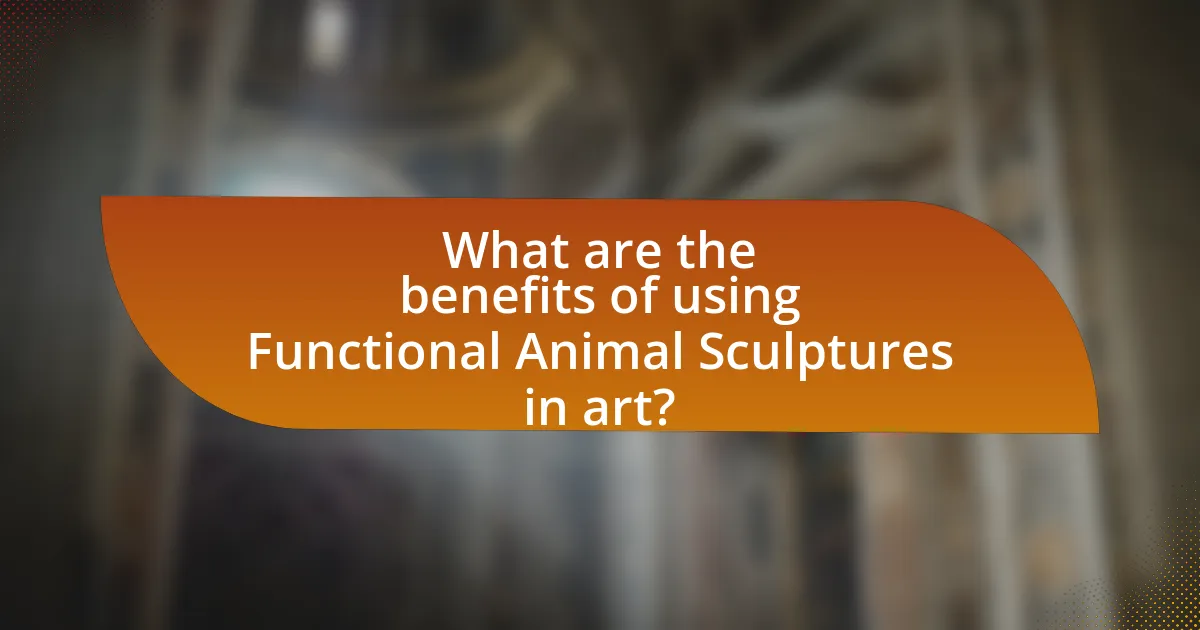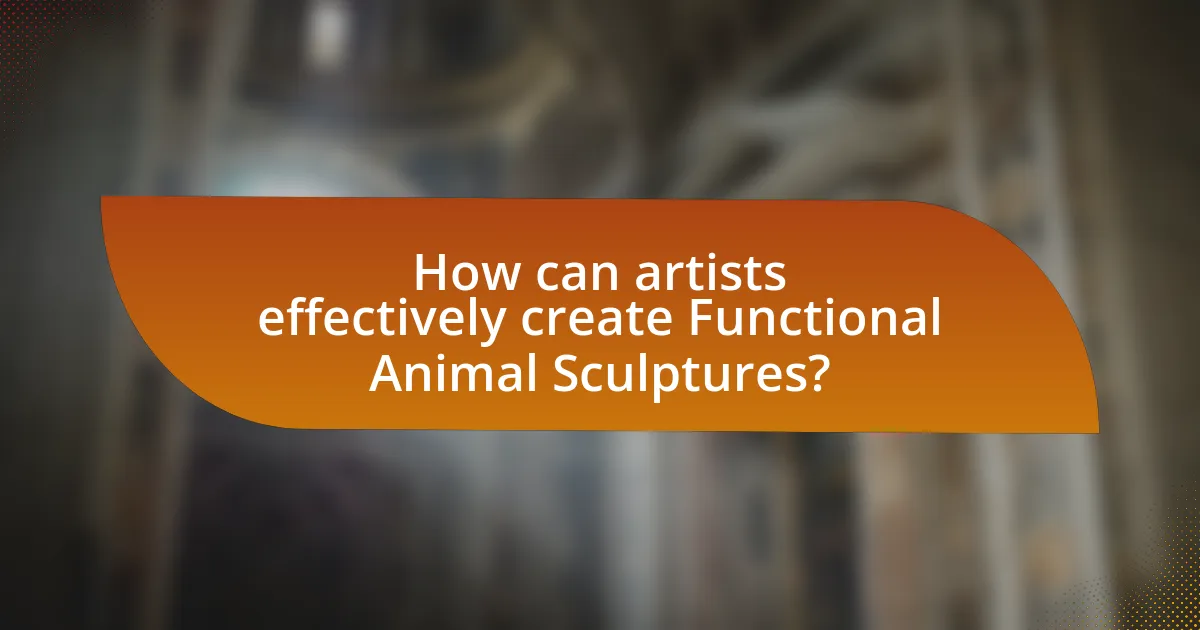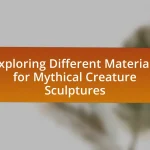Functional animal sculptures in sustainable art practices are artworks that serve practical purposes while promoting environmental consciousness and animal representation. These sculptures utilize recycled or eco-friendly materials, reducing waste and encouraging renewable resource use. The article explores how these sculptures contribute to sustainability, the materials commonly used, their significance in contemporary art, and the messages they convey about wildlife conservation. Additionally, it discusses the challenges artists face in creating these works, the economic advantages they offer, and the resources available for artists interested in this field.

What are Functional Animal Sculptures in Sustainable Art Practices?
Functional animal sculptures in sustainable art practices are artworks designed to serve a practical purpose while embodying themes of environmental consciousness and animal representation. These sculptures often utilize recycled or eco-friendly materials, promoting sustainability by reducing waste and encouraging the use of renewable resources. For instance, artists may create functional pieces such as furniture or garden installations that reflect animal forms, thereby merging utility with artistic expression. This approach not only highlights the importance of wildlife conservation but also engages the audience in a dialogue about the relationship between art, nature, and sustainability.
How do Functional Animal Sculptures contribute to sustainability?
Functional animal sculptures contribute to sustainability by utilizing recycled materials and promoting environmental awareness. These sculptures often incorporate waste products, such as scrap metal or discarded plastics, thereby reducing landfill waste and encouraging the repurposing of materials. For instance, artists like John Lopez create large-scale sculptures from salvaged metal, which not only serve as art but also highlight the importance of recycling and conservation. Additionally, functional animal sculptures can serve practical purposes, such as garden decor or furniture, which further extends their utility and reduces the need for new resources. This dual role of art and function exemplifies how creative practices can align with sustainable principles, fostering a culture of environmental responsibility.
What materials are commonly used in creating these sculptures?
Common materials used in creating functional animal sculptures include recycled metals, wood, clay, and biodegradable materials. Recycled metals, such as aluminum and steel, are favored for their durability and sustainability, as they reduce waste and energy consumption in production. Wood is often sourced from reclaimed timber, promoting environmental responsibility. Clay is utilized for its versatility and natural properties, while biodegradable materials, like plant fibers, are increasingly popular for their minimal environmental impact. These materials align with sustainable art practices by emphasizing resource conservation and ecological awareness.
How do these materials impact the environment?
Functional animal sculptures made from sustainable materials positively impact the environment by reducing waste and promoting eco-friendly practices. These materials, such as reclaimed wood, recycled metals, and biodegradable substances, minimize the carbon footprint associated with traditional art production. For instance, using reclaimed wood prevents deforestation and reduces landfill waste, while recycled metals decrease the need for new mining operations, which can be environmentally destructive. Additionally, biodegradable materials ensure that sculptures do not contribute to long-term pollution, as they break down naturally over time. This approach aligns with sustainable art practices that prioritize environmental stewardship and resource conservation.
Why are Functional Animal Sculptures significant in contemporary art?
Functional animal sculptures are significant in contemporary art because they blend aesthetic appeal with practical utility, promoting sustainability and environmental awareness. These sculptures often utilize recycled materials, thereby reducing waste and encouraging a dialogue about ecological responsibility. For instance, artists like David Mach and his use of reclaimed materials in animal sculptures exemplify how art can serve both a decorative and functional purpose while addressing pressing environmental issues. This duality enhances the relevance of functional animal sculptures in contemporary art, as they not only captivate viewers but also inspire them to consider their impact on the planet.
What messages do these sculptures convey about wildlife and conservation?
These sculptures convey messages about the importance of wildlife preservation and the need for conservation efforts. By depicting animals in their natural habitats, the sculptures highlight the beauty and diversity of wildlife, serving as a reminder of what is at stake due to habitat destruction and climate change. Furthermore, the use of sustainable materials in their creation emphasizes the role of art in promoting environmental responsibility and awareness. This aligns with the growing movement in sustainable art practices, which seeks to inspire action towards protecting ecosystems and biodiversity.
How do artists incorporate cultural elements into these sculptures?
Artists incorporate cultural elements into sculptures by drawing inspiration from traditional motifs, symbols, and techniques specific to their cultural heritage. For instance, many artists utilize indigenous patterns or storytelling methods that reflect their community’s history and values, thereby embedding cultural significance into the artwork. This practice is evident in the use of materials that are locally sourced and culturally relevant, such as clay or wood, which not only enhances the aesthetic but also connects the sculpture to the artist’s cultural identity. Additionally, artists often engage with cultural narratives or folklore, transforming these stories into visual forms that resonate with both local and global audiences, thus reinforcing the cultural context of the sculptures.
What are the different types of Functional Animal Sculptures?
Functional animal sculptures can be categorized into several types, including furniture, home decor, garden art, and utilitarian objects. Furniture sculptures, such as chairs or tables shaped like animals, serve both aesthetic and practical purposes. Home decor sculptures, like wall hangings or figurines, enhance interior spaces while often conveying artistic themes. Garden art includes sculptures that can withstand outdoor conditions, adding beauty to landscapes while sometimes serving as planters or bird feeders. Utilitarian objects, such as storage containers or lighting fixtures designed in animal forms, combine functionality with artistic expression. These categories illustrate how functional animal sculptures contribute to sustainable art practices by repurposing materials and promoting eco-friendly design.
How do these types vary in purpose and design?
Functional animal sculptures vary in purpose and design primarily based on their intended use and the materials employed. For instance, sculptures designed for educational purposes often incorporate realistic anatomical features to facilitate learning, while those intended for decorative use may prioritize aesthetic appeal over accuracy. Additionally, the design of sculptures can reflect sustainability practices, utilizing recycled materials or eco-friendly processes, which further distinguishes their purpose. Research indicates that artists increasingly focus on integrating functionality with environmental consciousness, as seen in the works of contemporary artists who create sculptures that serve both artistic and practical roles, thereby promoting sustainable art practices.
What role does functionality play in their artistic expression?
Functionality serves as a critical element in the artistic expression of functional animal sculptures, as it merges aesthetic appeal with practical use. Artists create these sculptures not only to convey artistic vision but also to serve specific purposes, such as habitat enhancement or educational tools. For instance, sculptures designed as birdhouses or bee hotels exemplify how functionality can promote biodiversity while simultaneously showcasing artistic creativity. This dual role enhances the viewer’s experience by inviting interaction and engagement, thereby reinforcing the importance of sustainability in art practices.
How do Functional Animal Sculptures engage the audience?
Functional animal sculptures engage the audience by combining aesthetic appeal with practical use, creating an interactive experience. These sculptures often serve as functional objects, such as furniture or garden decor, which encourages viewers to interact with them physically and emotionally. For example, a sculpture that doubles as a bench invites people to sit and appreciate the artistry while also fulfilling a practical need. This duality fosters a deeper connection, as the audience not only observes but also utilizes the artwork in their daily lives, enhancing their appreciation for both the artistic and functional aspects.
What challenges do artists face in creating sustainable sculptures?
Artists face several challenges in creating sustainable sculptures, primarily related to sourcing eco-friendly materials, balancing aesthetics with environmental impact, and ensuring durability. Sourcing sustainable materials can be difficult due to limited availability and higher costs compared to traditional materials. Additionally, artists must navigate the challenge of creating visually appealing works while adhering to sustainable practices, which can restrict design options. Durability is another concern, as sustainable materials may not always withstand environmental conditions as well as conventional materials, potentially leading to shorter lifespans for the sculptures. These challenges highlight the complexities artists encounter in merging artistic expression with sustainability in their work.

What are the benefits of using Functional Animal Sculptures in art?
Functional animal sculptures in art provide both aesthetic appeal and practical utility, enhancing the viewer’s experience while promoting sustainability. These sculptures often serve as functional objects, such as furniture or home decor, which encourages the integration of art into everyday life. Additionally, they can be crafted from recycled or sustainable materials, aligning with eco-friendly practices and reducing environmental impact. For instance, artists like David Smith have utilized scrap metal to create sculptures that are both visually striking and environmentally conscious, demonstrating how functional art can contribute to sustainable practices.
How do these sculptures promote environmental awareness?
These sculptures promote environmental awareness by visually representing the impact of human activity on wildlife and ecosystems. Through their design and materials, they often incorporate recycled or sustainable elements, highlighting the importance of conservation and responsible consumption. For instance, sculptures made from reclaimed materials serve as a tangible reminder of waste reduction and the potential for repurposing, thereby encouraging viewers to reflect on their own environmental footprint. Additionally, these artworks often depict endangered species or habitats, raising awareness about biodiversity loss and the urgent need for preservation efforts.
What educational opportunities do they provide for the public?
Functional animal sculptures in sustainable art practices provide educational opportunities through workshops, exhibitions, and community engagement programs. These initiatives teach participants about sustainable materials, artistic techniques, and the ecological significance of animal forms in art. For example, workshops often include hands-on experiences where individuals learn to create sculptures using recycled materials, fostering awareness of environmental issues. Additionally, exhibitions showcase the intersection of art and sustainability, encouraging discussions on conservation and the role of art in promoting ecological awareness.
How can they inspire action towards sustainability?
Functional animal sculptures can inspire action towards sustainability by demonstrating the potential of repurposed materials and promoting environmental awareness. These sculptures often utilize recycled or sustainable resources, showcasing how art can contribute to ecological conservation. For instance, artists like Chris Jordan use discarded materials to create impactful pieces that highlight waste and consumption, effectively engaging audiences in conversations about sustainability. This approach not only raises awareness but also encourages individuals to consider their own consumption habits and the importance of sustainable practices in their daily lives.
What economic advantages do Functional Animal Sculptures offer?
Functional Animal Sculptures provide economic advantages by creating unique, marketable products that attract consumers interested in sustainable art. These sculptures often utilize recycled materials, reducing production costs and appealing to environmentally conscious buyers. Additionally, they can serve dual purposes, functioning as both art and practical items, which enhances their value and marketability. The growing demand for sustainable and functional art has been evidenced by a 2021 report from the National Endowment for the Arts, which highlighted a 20% increase in sales for eco-friendly art products over the previous five years. This trend indicates that Functional Animal Sculptures not only contribute to artistic expression but also support economic growth within the sustainable art sector.
How do they contribute to local economies through tourism and sales?
Functional animal sculptures contribute to local economies through tourism and sales by attracting visitors to art installations and galleries, thereby increasing foot traffic and spending in the area. For instance, communities that host exhibitions or festivals featuring these sculptures often report a rise in local business revenue, as tourists spend on accommodations, dining, and shopping. A study by the National Endowment for the Arts found that arts-related tourism can generate significant economic impact, with visitors spending an average of $27 per person per day on local goods and services. This economic activity not only supports local artisans and businesses but also fosters community development and cultural exchange.
What funding opportunities exist for artists working in this medium?
Funding opportunities for artists working in functional animal sculptures include grants from organizations focused on sustainable art, such as the Sustainable Arts Foundation, which provides financial support specifically for artists with children. Additionally, the National Endowment for the Arts offers project grants that can be applied to innovative art practices, including those that emphasize sustainability. Furthermore, local arts councils often have funding programs that support community-based art projects, which can include functional sculptures. These funding sources are designed to promote artistic endeavors that align with sustainable practices and community engagement.

How can artists effectively create Functional Animal Sculptures?
Artists can effectively create functional animal sculptures by integrating practical design with artistic expression. This involves selecting materials that are both durable and sustainable, such as reclaimed wood or recycled metals, which not only enhance the sculpture’s functionality but also align with eco-friendly practices. Additionally, artists should focus on the intended use of the sculpture, whether it serves as furniture, garden decor, or a utility item, ensuring that the design accommodates its purpose while maintaining aesthetic appeal.
For instance, sculptures that double as seating or planters can attractively blend art with utility, thereby promoting sustainable art practices. The incorporation of functional elements into the design process can be validated by the growing trend of artists like David Smith, who created sculptures that serve practical purposes while also being visually striking. This approach not only enhances the value of the artwork but also encourages a deeper connection between the viewer and the piece, fostering appreciation for both art and sustainability.
What best practices should artists follow in sustainable art creation?
Artists should prioritize the use of eco-friendly materials and techniques in sustainable art creation. This includes selecting non-toxic paints, recycled or upcycled materials, and sustainable sources for natural elements. For instance, using bamboo, which is a rapidly renewable resource, can significantly reduce environmental impact. Additionally, artists should consider the lifecycle of their artworks, aiming for pieces that can be reused or repurposed, thereby minimizing waste. Research indicates that sustainable practices not only benefit the environment but also resonate with audiences increasingly concerned about ecological issues, enhancing the relevance and marketability of the artwork.
How can artists source eco-friendly materials?
Artists can source eco-friendly materials by utilizing sustainable suppliers, recycled resources, and natural alternatives. Sustainable suppliers often provide materials that are certified organic or sourced from renewable resources, ensuring minimal environmental impact. Recycled resources, such as reclaimed wood, metal, or fabric, reduce waste and promote circular economy practices. Additionally, artists can explore natural alternatives like plant-based dyes, biodegradable glues, and non-toxic finishes, which are safer for both the environment and human health. These sourcing methods align with sustainable art practices, contributing to a reduced ecological footprint in the creation of functional animal sculptures.
What techniques enhance the functionality of the sculptures?
Techniques that enhance the functionality of sculptures include the integration of kinetic elements, the use of sustainable materials, and the incorporation of interactive features. Kinetic elements allow sculptures to move or change position, engaging viewers and creating a dynamic experience. Sustainable materials, such as recycled metals or biodegradable substances, not only reduce environmental impact but also contribute to the artwork’s longevity and relevance in sustainable art practices. Interactive features, like sound or light components, invite audience participation, making the sculptures more engaging and functional in public spaces. These techniques collectively elevate the sculptures’ purpose beyond mere aesthetics, aligning them with contemporary sustainable art practices.
What resources are available for artists interested in this field?
Artists interested in the field of functional animal sculptures in sustainable art practices can access various resources including online platforms, workshops, and grants. Websites like ArtStation and Behance provide exposure and networking opportunities, while organizations such as the Sculpture Network offer workshops and exhibitions focused on sustainable practices. Additionally, grants from institutions like the National Endowment for the Arts support projects that align with sustainability goals. These resources facilitate skill development, community engagement, and financial support, essential for artists pursuing this niche.
How can artists collaborate with conservation organizations?
Artists can collaborate with conservation organizations by creating awareness through their art, participating in fundraising events, and engaging in joint projects that promote environmental sustainability. For instance, artists can design functional animal sculptures that highlight endangered species, thereby drawing public attention to conservation efforts. Collaborative projects can include workshops where artists and conservationists work together to educate communities about biodiversity, as seen in initiatives like the “Art for Conservation” program, which successfully merges artistic expression with ecological education. This partnership not only enhances the visibility of conservation issues but also fosters a deeper connection between art and environmental stewardship.


